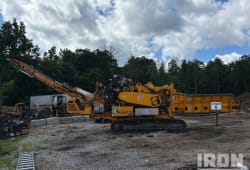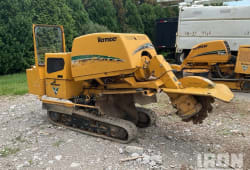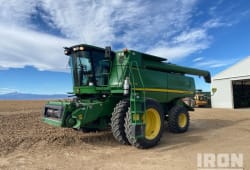Unlocking the Power of Logging Equipment: A Comprehensive Guide
6 Min read
)
September 17, 2023
Logging, the process of harvesting timber, has evolved significantly over the years thanks to the development of advanced forestry equipment. Modern logging operations are now more efficient, environmentally friendly, and safer than ever before.
In this comprehensive list, we will explore seven different types of logging equipment, understanding what they are, how they are used, and the benefits they bring to the forestry industry.
1. Fixed Tooth Rotor System
:format(webp))
A Fixed Tooth Rotor System is a component found in forestry machines, particularly in mulching and grinding equipment for woods. It consists of a rotor with fixed teeth that shred and mulch tree stumps, branches, forest materials, and vegetation.
How is it Used?
A Fixed Tooth Rotor System, also known as a mulcher, is one of the most important pieces of logging machinery you can operate.
After loggers cut logs, there are stumps and other debris left over that need to be cleared out. The mulcher uses a rotor with self-propelled teeth that shred any debris red into them.
This equipment is used to clear land and remove tree stumps efficiently. It can process trees, branches, and entire tree stumps, converting them into mulch or small chips.
Benefits
The Fixed Tooth Rotor System is highly effective at clearing land and preparing it for reforestation or development. It reduces the need for manual labor and minimizes the environmental impact of land clearance.
2. Logging Trucks
:format(webp))
Logging trucks are heavy-duty vehicles specially designed for transporting logs from the forest to sawmills or processing facilities. They come in various sizes and configurations.
How are They Used?
Logging trucks are the equipment used for logging and transporting entire trees or processed logs from the forest to the destination. They are equipped with loading mechanisms to load and unload logs efficiently.
Benefits
Logging trucks streamline the transportation of logs, reducing handling and labor costs. They are built to withstand the rugged conditions of forest roads and ensure the safe and efficient movement of timber.
3. Log Loaders
:format(webp))
Log loaders are specialized forestry machines equipped with grapples or clamps for lifting and loading logs onto trucks or other transport vehicles.
How are They Used?
Log loaders are machines used to handle and load logs onto logging trucks. They can efficiently process trees simultaneously, increasing productivity.
Benefits
Log loaders significantly expedite the log-loading process, reducing downtime and increasing the efficiency of logging operations. They also enhance safety by minimizing manual handling of heavy logs.
4. Wheeled Feller Bunchers
:format(webp))
Wheeled feller bunchers are logging machines that revolutionized the way logging is done. These fantastic machines are designed to cut wood and gather multiple trees simultaneously. They are equipped with felling heads and grapple attachments, allowing them to complete almost all the tasks required for logging.
How are They Used?
Wheeled feller bunchers are used to fell trees and then gather and stack them for processing or transportation. They are highly efficient at processing trees in bulk. However, remember that they work best on groups of small trees with a single stem. Large trees with multiple stems will be more difficult to manage with just tracked feller bunchers.
Benefits
These machines dramatically increase the efficiency of logging operations. They can process trees much faster than manual methods with their large blade, reducing labor costs and increasing productivity. They allow you to complete multiple tasks without needing other equipment. One feller buncher can take the place of both a grapple skidder and a cutting head or felling heads.
5. Tracked Machines
:format(webp))
Tracked machines are logging equipment equipped with tracks instead of wheels. They are the machinery designed for improved mobility on challenging and uneven terrain.
How are They Used?
Tracked machines are used in rugged and remote logging locations where traditional wheeled equipment may struggle to operate. They provide stability and traction on steep slopes and in adverse weather conditions.
They are frequently used in wet or winter conditions where a regular logging truck would have difficulty keeping balance on the forest floor.
Benefits
Tracked machines offer enhanced maneuverability capabilities in challenging terrain, enabling access to timber resources that might otherwise be inaccessible. They reduce soil disturbance and minimize environmental impact in sensitive areas.
6. Swing Machines
:format(webp))
Swing machines, also known as swing yarders, swing loaders, or swinging hammer, are specialized equipment used in logging to process trees and transport logs. They feature a rotating cutting disk and a grapple system to pull them.
How are They Used?
Swing machines are used to fell, process, and load logs onto trucks. They typically have a fixed boom that allows them to easily lift heavy logs and move them onto or off of trucks or other pieces of machinery. They have the advantage of a rotating cutting disk that can reach limbs and process trees in different directions.
Benefits
Swing machines offer versatility in logging operations, enabling efficient tree processing and log loading. They can access trees from various angles, increasing efficiency and reducing the need for repositioning.
7. Wheeled Machines
:format(webp))
Wheeled machines, such as wheeled feller bunchers, are logging equipment equipped with wheels rather than tracks. They are designed for mobility on smoother ground surfaces.
How are They Used?
Wheeled machines are used in logging operations in forests where the terrain is relatively flat or less challenging. Wheeled harvesters are efficient at felling and processing trees in these conditions and can do so much more quickly than tracked harvesters.
Benefits
Wheeled machines are cost-effective options for logging operations in less rugged terrain. They provide mobility and efficiency while reducing the overall environmental impact on the land. They also allow you to complete tasks much more quickly as long as you have enough space between the trees and even ground.
Conclusion
In conclusion, modern forestry equipment has revolutionized the logging industry, making it more efficient, safe, and sustainable. Each type of equipment serves a specific purpose, from felling and processing trees to transporting logs.
By choosing the right equipment for the job and utilizing advanced technology, logging operations can minimize environmental impact, reduce labor costs, and increase productivity, ensuring a brighter and more sustainable future for the forestry industry.
If you're interested in purchasing new forestry equipment, make sure to check out Boom and Bucket. Boom and Bucket offers various types of used logging equipment at an affordable price, making it easy to get high-quality machines without breaking the bank.

Javier Bocanegra is Boom & Bucket's Technical Resolutions Lead, drawing on 10+ years in automotive and heavy equipment to diagnose issues, resolve complex post-sale cases, and keep machines - and customers - running smoothly. A certified heavy-equipment specialist, he's known for meticulous inspections and hands-on expertise across mechanical, electrical, and hydraulic systems. Based in Sacramento, Javier partners closely with buyers, vendors, and our field teams to deliver reliable outcomes and uphold our standards for safety and trust.











